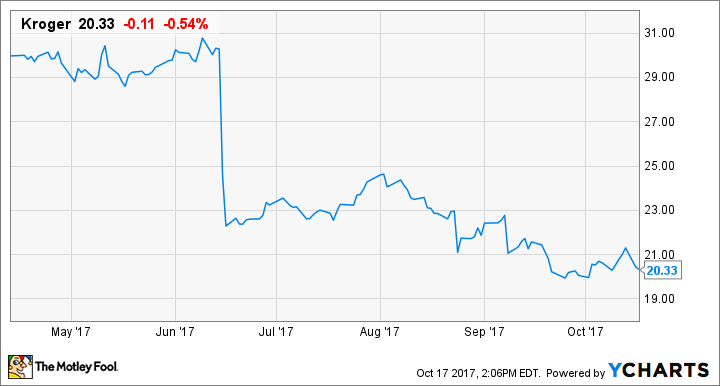3 Things Kroger Must Do to Compete With Amazon's Whole Foods
Kroger's (NYSE: KR) stock fell 26% in June following Amazon.com's (NASDAQ: AMZN) acquisition of Whole Foods, and it has yet to recover.
Investors are left wondering if the traditional grocer has what it takes to compete in an industry that the tech-savvy retail giant Amazon is taking by storm. Foot traffic at Whole Foods stores soared over 25% in the first two days after Amazon introduced discounted food prices in late August, as location intelligence company Foursquare told CNBC.
Kroger wasn't the only grocer that took a hit. Shares of Wal-Mart and Target (NYSE: TGT) also fell in mid-June, as investors feared these grocers that might turn into the new Macy's or Sears Holdings.
Kroger's latest financial report in early September didn't help matters. For the latest quarter, Kroger's net income dropped to $353 million, or $0.39 per share, from $383 million, or $0.40 per share, in the year-ago period. Although revenue climbed 3.9% to $27.60 billion, same-store sales climbed a disappointing 0.7%, versus the 1.7% climb in the second quarter of 2016.
If Kroger wants to compete with the Amazon-Whole Foods combo and succeed in the long term, then it needs to do three things, said Brittain Ladd, a Seattle-based consultant in retail strategy, supply chain, and logistics. Ladd, who previously worked on the Amazon Fresh expansion team, declined to confirm if he is currently supporting Kroger in any capacity.
1. Re-engineer the supply chain
Kroger has about 2,800 retail food stores in 35 states and the District of Columbia, making it the biggest supermarket chain in the U.S. The store is known for its affordable organic brand, Simple Truth, which did $1.7 billion in sales in 2016. The brand is often favorably contrasted with the more expensive organic brands found at Whole Foods, which Amazon is working to make more affordable.
Kroger has spent the bulk of its attention on improving the in-store experience for its now 8.5 million customers per day. But in 2017, Kroger should be focusing on becoming more omnichannel, allowing customers to order via desktop or mobile, in-store, or by phone.
"In order to compete and become a growth stock, Kroger must conduct advanced product flow path, distribution, and logistics design studies to implement a supply chain capable of meeting the needs of physical and digital customers," Ladd explained.

Customers have more choices than ever when it comes to buying groceries. Image source: Getty Images.
2. Invest in technology and infrastructure
Kroger has stepped up its tech game this year out of necessity. Amazon started as a tech and retail company and is now getting into the grocery business. How does a traditional grocery player compete with that?
Kroger has been working to improve the customer experience with such things as a mobile app that produces digital coupons corresponding to the user's shopping habits. Kroger is also trying to get a better picture of what customers are interested in by installing in-store cameras and sensors to monitor foot traffic.
However, because Kroger is a long-established company, most of its grocery retailers are using old versions of legacy software. The company is working to improve its in-house tech systems, but it's an uphill climb, especially with Amazon swooping into the sector to give Whole Foods a boost with its top class software. Kroger is at a disadvantage.
One glaring example of Kroger's out-of-date technology is the system used to check which products are out of stock. The company doesn't have full visibility into which products are available in all of its stores, leading some customers to show up to pick up digital orders only to find that substitutions were made for items they requested. To compete with Amazon, Kroger needs to provide a seamless and enjoyable customer experience for both in-store and digital customers.
3. Expand Kroger's brand
Kroger may be the largest supermarket retailer in the U.S., but it still doesn't have an international presence. Meanwhile, Amazon announced last December that Amazon Prime had expanded to a total of 242 countries. By hooking customers into its Prime services, Amazon can more easily entice them to also use its convenient grocery services, including AmazonFresh and Whole Foods.
Kroger must work to maximize customer experience and sales in every store it operates, but even that may not be enough, according to Ladd. If Kroger wants to survive and grow in the long term, it needs to consider an international presence and strategic options with other companies. "Kroger must commit to identifying acquisitions and partnerships that will position Kroger for growth and increased competitiveness," Ladd said.
In other words, Kroger needs to think bigger, just as Amazon does, according to Ladd. One possibility to increase its competitiveness in the U.S. includes merging with Target. Kroger would give Target a complete grocery business, while Target would give Kroger an expanded retail experience with electronics, home goods, and other items. Another option would be for Kroger and Costco to discuss strategic options. An acquisition of warehouse retailer BJ's Wholesale Club or online retailer Boxed are also worth exploring, according to Ladd.
A way to ingrain its brand into the lives of baby boomers, millennials, and generation Z is to increase its digital presence through cooking videos and online recipe platforms, as well as to extend its convenient services to choose-your-own-ingredients meal kits and in-store cooking seminars. Kroger might even decide to release its own affordable cookware, Ladd added. Like Amazon, Kroger needs to build a trustworthy brand that slowly becomes a part of people's everyday lives.
Kroger needs to step its game up
Kroger is not in nearly as bad a place as Sears, which many say is simply delaying bankruptcy. The grocer is the largest supermarket in the U.S., it's been improving its digital presence, and its revenue is still growing. Right now, Kroger needs to commit to completing these three tasks and fighting hard to stay in the game with Amazon.
More From The Motley Fool
6 Years Later, 6 Charts That Show How Far Apple, Inc. Has Come Since Steve Jobs' Passing
Why You're Smart to Buy Shopify Inc. (US) -- Despite Citron's Report
John Mackey, CEO of Whole Foods Market, an Amazon subsidiary, is a member of The Motley Fool’s board of directors. Natalie Walters has no position in any of the stocks mentioned. The Motley Fool owns shares of and recommends Amazon. The Motley Fool recommends Costco Wholesale. The Motley Fool has a disclosure policy.

 Yahoo Finance
Yahoo Finance 
